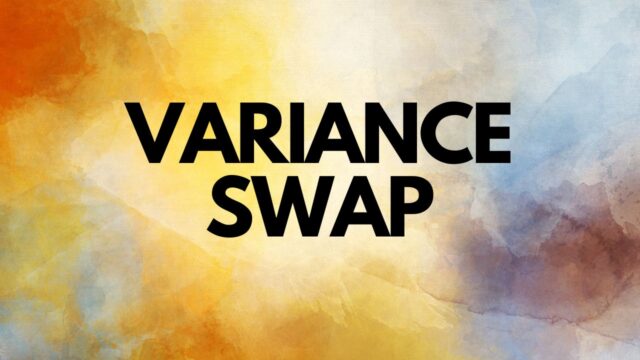
Definition
A variance swap is an over-the-counter financial derivative that allows one to speculate on or hedge risks associated with the magnitude of movement, i.e. volatility, of some underlying product, like an exchange rate, interest rate, or stock index.
Benefits and Disadvantages of Variance Swaps
A Variance Swap is an over-the-counter financial derivative that allows you to speculate on volatility and hedge risks. The variables that you can trade on are interest rates, exchange rates, and stock indexes. Here is a quick review of these instruments and their uses. Listed below are some benefits and disadvantages of variance swaps.
Variance
A Variance Swap is an over-the-counter financial derivative that enables traders to hedge risks and speculate on volatility. The market for this product can vary in value depending on the volatility of an interest rate, a stock index, or an exchange rate. This instrument is used to hedge risks and earn profit by paying a premium at the time of volatility, which is called the “rev-rate.”
To determine the volatility of the market, the variance swap must be valued. The volatility of the underlying asset should be known to the parties involved. For example, if an investor sells a commodity, the value will fall by 20%. A trader might buy a commodity in order to offset the loss. The price of that commodity can fluctuate dramatically, and the volatility of a commodity will change daily. Variance swaps that are not well known will have a higher volatility.
Volatility risk premium
A variance swap for volatility risk premium is an alternative to using options to hedge against volatility. The difference between an option’s strike price and its realized value is the variance. The premium is paid by the buyer of the volatility swap to offset the difference between the strike price and the volatility realized at maturity. This offset is greater than the variance of the underlying asset. Traders who want to hedge against volatility use a variance swap as an alternative to using options.
The term structure of equity and variance swaps has been studied in order to understand the market behavior of these instruments. The two types of swaps are used to estimate market premia for hedging against volatility risk. The results show that the term structure of variance swaps can produce more accurate estimates of the volatility risk premium than implied volatility in the option market. Empirical research shows that the volatility risk premium is negatively convex during times of crisis. However, the effect persists even when the market is not in crisis.
Replication formula
Price variance swaps are a popular replication formula. This strategy assumes that traded option strikes are continuous, whereas volatility swaps are only approximately replicated using a static portfolio of vanilla options. Both types of swaps can be valued using a calibrated Heston model. A FINCAD Analytics Suite can also calculate the value of volatility swaps. Alternatively, you can use the Variance Swap Replication Formula (VSRF).
To calculate the price of a volatility swap, you first need to know how much volatility it can generate. Volatility is a derivative of the price of the underlying asset. Therefore, volatility can be calculated by multiplying the price of the underlying asset by the square root of its strike. Because the relationship is not linear, a static options portfolio cannot replicate volatility swaps. You need an approximate replication strategy that combines a volatility swap with a unit notional. FINCAD Analytics Suite’s simulation tool allows you to perform the approximate replication of a volatility swap portfolio by using implied volatility and fair value.
Payoff
A variance swap is a type of over-the-counter financial derivative. It enables you to speculate on volatility of an underlying asset and hedge your risks. The asset could be an exchange rate, interest rate, stock index, or any combination thereof. When you invest in a variance swap, you are essentially hedging your risk by trading two different underlying assets. Here are some of the main benefits of a variance swap.
In a variance swap, you pay a predetermined amount to take the underlying asset in return for a variable. When the underlying price rises, the payoff for the swap is greater than the volatility risk. On the other hand, if the underlying price declines, you will lose less money in a variance swap than in a volatility swap. The difference between the uncapped and capped strike price represents the value of the call on variance.
Cryptocurrency Variance Swap
A new cryptocurrency product called the Cryptocurrency Variance Swap has recently been introduced. It will help you protect your profits against volatility in the Bitcoin price. Bitcoin has been extremely volatile since its inception, and this volatility has led to many traders and investors abandoning the space. However, as the digital asset market continues to develop, more products are being introduced to meet the needs of the growing crypto community. The latest structured product in this space is the Cryptocurrency Variance Swap, which allows institutions and traders to hedge their risk against volatile price movements.
The price of a bitcoin variant can fluctuate by hundreds of percent. The most common method of swapping is through an exchange. This type of trade requires users to register for an account with a cryptocurrency exchange. To do this, users must provide personal information about themselves. Afterwards, they can send the currencies they want to swap to the exchange platform. For example, if they want to swap Bitcoin for Ethereum, they can send the former to the exchange platform. Once the transaction is completed, they will receive the newly acquired crypto on the exchange platform.


































